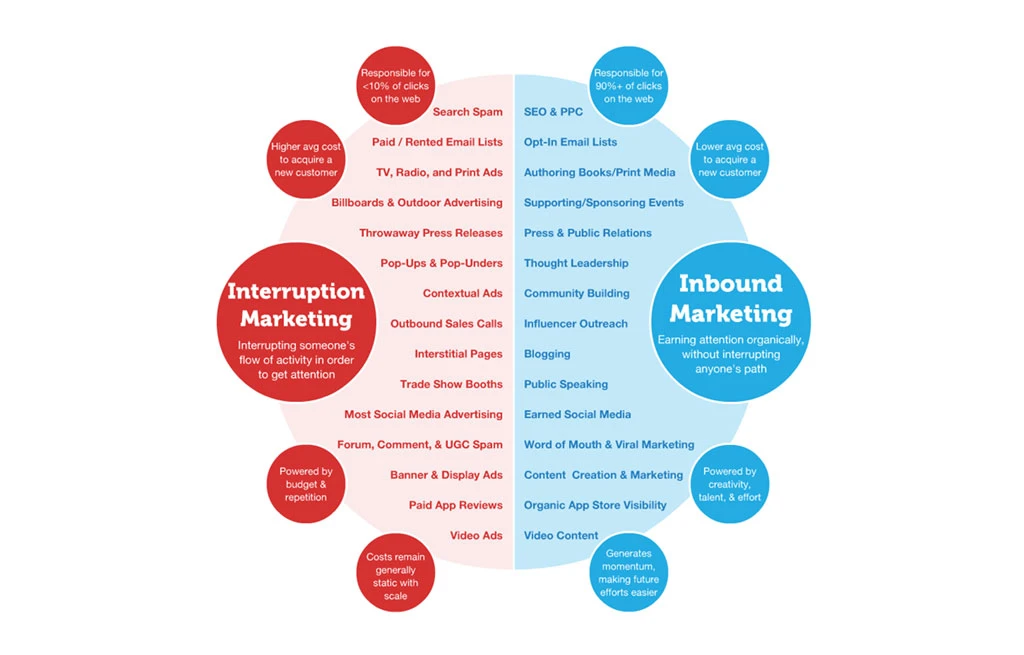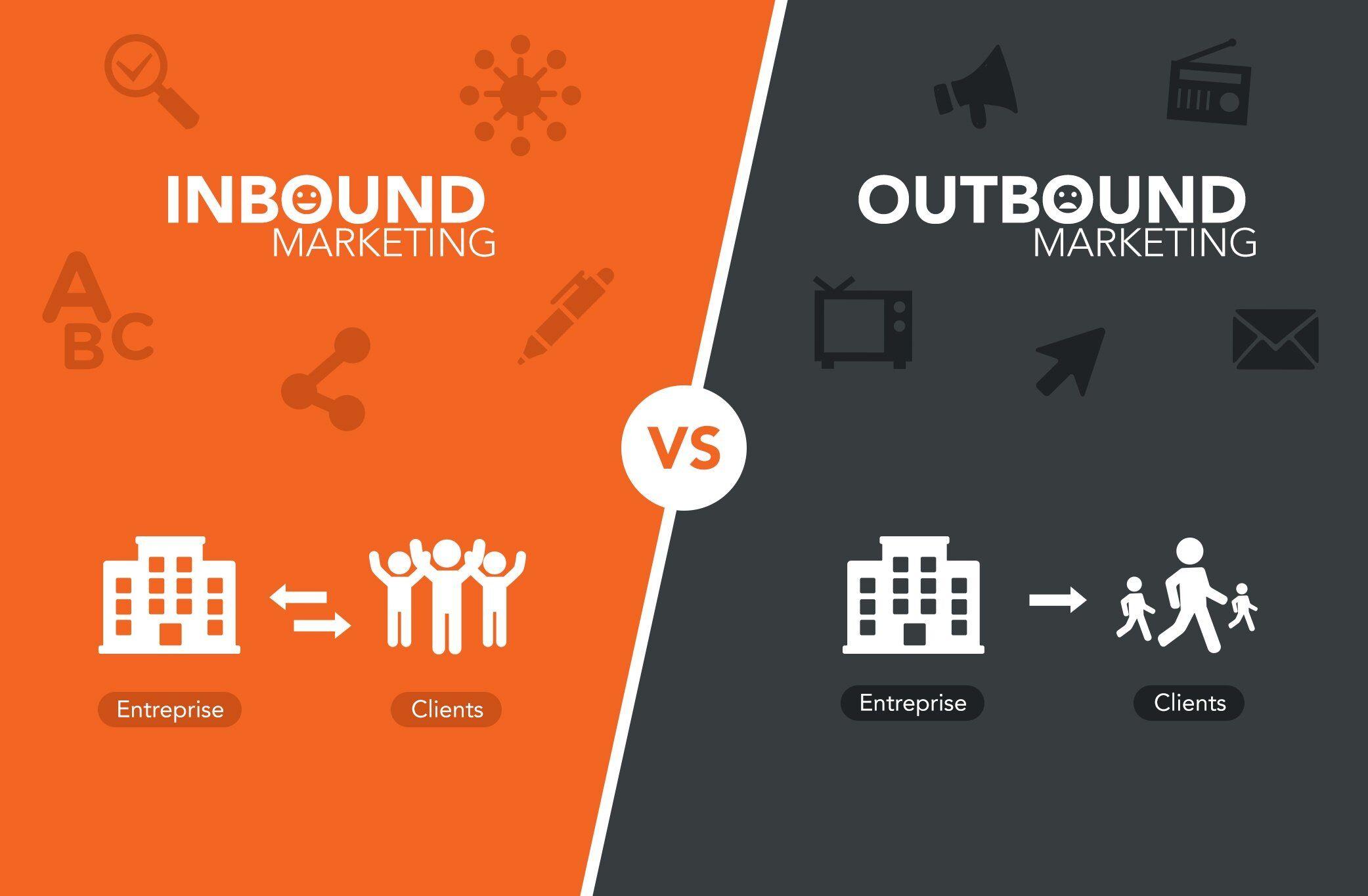The survival and progress of any company largely depend on its marketing strategy. It is a big challenge to adopt the right approach of marketing, reviewing your business methods and goals. There are two main marketing methods that you can apply in your business; Inbound marketing and Outbound marketing. Inbound marketing focuses on attracting potential customers through valuable and educational content, while Outbound marketing involves reaching potential customers through ads and other interruptive methods.
But what are the pros and cons of inbound vs outbound marketing? And how can they help marketers determine the best approach for their business? Understanding the benefits and drawbacks of each method, they can develop an effective marketing strategy that enables them achieve all goals and reach their target audience.
What Is Inbound And Outbound Marketing?
Inbound marketing and outbound marketing have their own characteristics for business development, but it is essential to understand each before choosing the best approach for your business. Let’s learn about these two essential marketing strategies.
Inbound marketing is the marketing strategy where you can attract customers to the company through content creation, search engine optimization, and social media marketing. The main goal of inbound marketing is to create valuable content that converts customers to the company’s website and builds trust with them. It is often seen as more cost-effective, targeted, and less intrusive. This strategy can be effective to develop long-term relationships with your customers.
Outbound marketing is a more traditional, product-centric approach that involves reaching potential customers through ads, telemarketing, and direct mail. The goal is to generate leads and sales by directly promoting products or services to potential customers. Often seen as less targeted and more intrusive than inbound marketing, as it relies on interrupting potential customers to promote your products or services.
Inbound Vs Outbound Marketing: Main Differences
You can easily choose the most effective approach for reaching your target audience by understanding the different examples of inbound and outbound marketing. We will comparatively discuss several examples of inbound vs outbound marketing to help you understand the key differences between these two approaches and their benefits.
Inbound Marketing Examples
Inbound marketing is designed to build relationships with potential customers by providing them with relevant and valuable information and then converting them into loyal customers. Some examples of Inbound Marketing are,
- Content Marketing: Content marketing refers to creating and sharing valuable content, such as blog posts, ebooks, and videos, to attract and engage potential customers. This strategy will establish your business as an authority in your industry and build trust with your target audience.
- Search Engine Optimization (SEO): Proper SEO will rank your website on the first page of SERP(Search Engine Result Page). That will help your potential customers to find you easily when they search for keywords related to your products or services.
- Social Media Marketing: Social Media Marketing means to use social media platforms, such as Facebook, Twitter, and LinkedIn, to engage with potential customers and build relationships with them. It is an effective way of marketing as you will find most of your customers easily on Social media.
Outbound Marketing Examples
Outbound marketing is designed to reach a broad audience and generate leads and sales by directly promoting products or services. Some examples of Outbound Marketing are,
- Paid Advertising: In Paid Advertising, you can place ads on websites, social media platforms, or other channels to reach a broad audience and generate leads and sales.
- Direct Mail: Direct mail means sending promotional materials, such as brochures or flyers, directly to potential customers through the mail.
- Telemarketing: This marketing strategy involves calling potential customers to generate leads and sales. This is another quickly responsive marketing strategy.
Product Marketing
Inbound and Outbound product marketing are two main approaches to promoting and selling products, each with its strengths and weaknesses. The first one focuses on attracting customers with attractive and informative content, such as blog posts, ebooks, and videos. You will find Inbound marketing as more cost-effective, targeted, and less intrusive than outbound marketing.
On the other hand, Outbound product marketing involves directly promoting products or services to potential customers through interruptive methods, such as ads, telemarketing, and direct mail. Outbound marketing is often used for businesses with short-term sales goals and can deliver results quickly. However, outbound marketing can also be seen as less targeted and more intrusive than inbound marketing.
Inbound Vs Outbound Marketing: Pros and Cons


A successful product marketing strategy often involves a combination of both inbound and outbound marketing, using the strengths of each approach to reach and engage with your target audience effectively.
Inbound
Knowing about Inbound marketing pros and cons will help you make the right decision about marketing strategy.
Pros
- Cost-effective: Inbound marketing is often less expensive than outbound marketing, as it focuses on attracting customers through valuable content rather than paying for ads or interruptive methods.
- Builds Trust: Inbound marketing helps build trust with your customers by providing them with valuable, educational content. Inbound policies will help you to establish your brand as an authority in your own industry. That put a great impact on credibility and customer loyalty.
- Targeted: Inbound marketing is more targeted than outbound marketing, as it aims to attract customers who are already searching for the products or services you offer.
Cons
- Time-Consuming: Inbound marketing requires a lot of time and effort to create and distribute high-quality content. If you own a small business with limited resources, then inbound marketing can be challenging for you.
- Results Take Time: Another disadvantage of Inbound marketing is that the results can take several months to see. So, you should prepare your business before applying this strategy.
- Requires a Long-Term Commitment: Inbound marketing is a long-term strategy that requires consistent effort to see results. Your business must be willing to commit the resources needed to create and distribute valuable content regularly.
Outbound
This portion will help you to take Outbound marketing strategies for your business.
Pros
- Quick Results: Outbound marketing delivers results quickly, as it involves paid advertising, direct mail, telemarketing, and other methods that will generate your leads and sales immediately.
- Reaches a Wide Audience: Outbound marketing can reach a large audience quickly, making it ideal for businesses that need to generate leads and sales quickly.
- Good for Product Awareness: Outbound marketing is a great way to raise awareness of a new product or service, as it can reach a large audience quickly.
Cons
- Expensive: Outbound marketing is competitively expensive, as it involves paying for ads, direct mail, telemarketing, and other methods that can add up quickly.
- Interruptive: Outbound marketing can be seen as intrusive, as it involves interrupting people with ads or sales calls. Sometimes, these tactics put a negative perspective on a brand.
- Less Targeted: Outbound marketing is less targeted than inbound marketing, as it aims to reach as many people as possible rather than attracting customers who are already searching for the products or services you offer.
Final Thoughts
Inbound and outbound marketing are two distinct approaches to promoting and selling products, each with pros and cons. Inbound marketing is ideal for businesses that want to build customer trust and credibility over time. On the other hand, Outbound marketing is the best option for businesses that need to generate leads and sales quickly. In the end, it’s important to carefully consider your goals and resources while choosing the suitable marketing approach between inbound vs outbound marketing. Analyzing all the information above, we hope you can easily take the best marketing strategy for your business.





















Leave a Reply
View Comments